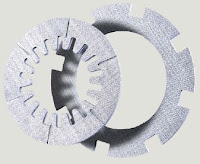Four clutch diameters (outer disc diameter) are available
|
| ||||
|
|
- 115 mm (4.5") => RCS 115
- 140 mm (5.5") => RCS 140
- 184 mm (7.25") => RCS 184
- 200 mm (7.875") => RCS 200
The greater the clutch diameter, the more torque can be transmitted by the clutch. The smaller the clutch diameter, the less mass and inertia. This means that low inertia (low mass) allows the engine to accelerate quickly. Larger clutches can accommodate much more heat and remain completely efficient, when smaller clutches may well be overheated.
Friction materials
Carbon is the high-tech material from the Formula 1. It is very temperature resistant and very light. This friction material is often used under very severe conditions and pro vides the possibility of compact lightweight clutches.
Advantages: Very light, extremely temperature resistant, good startline behavior, no flywheel wear, high durability, low mass and inertia.
Sinter
Sinter, due to its very light driven plates, is often used in applications such as circuit/track racing, formula series vehicles, and touring vehicles.
Advantages: Light, small clutch height, low mass and inertia
Sinter-Pad
Sinter-Pad offers high wear range and is often used in applications where there are numerous starts.
Advantages: High wear volume, high temperature resistance, long operational life.
Organic
Organic is a soft friction lining and therefore gearbox protective but not very temperature resistant. This type of material is not used in extreme race conditions.
Advantages: Easy on the transmission, soft clutch engagement, low wear on the flywheel friction surface.















.png)





